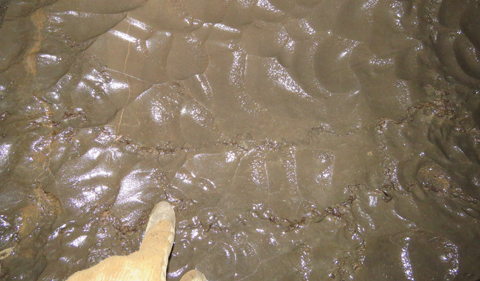Dr. Gregory S . Springer co-authored recent two articles, one in the International Journal of Speleology, the other in the Journal of Cave and Karst Studies.
Springer is Associate Professor and Chair of Geological Sciences at Ohio University.
In the International Journal of Speleology, Springer co-authored Uncertainties associated with the use of erosional cave scallop lengths to calculate stream discharges.
“Scallops are created by stream erosion in caves and their lengths reflect floodwater velocities. So, it is possible to use scallops to calculate floodwater velocities that cannot safely be observed. However, as with any technique, there are uncertainties such as how much error is there? Can the values be reproduced if we do the measurements again? Or, because we will probably not measure the same scallops will we end up with a different number?” Springer notes.
Andrew Hall, who recently graduated with a master’s in Geological Sciences, studied the uncertainty questions and measured over 1,700 scallop lengths standing in cold cave streams. This paper uses analyses by Hall and Springer’s analyses to estimate the error and uncertainties associated with using scallops to calculate velocities and stream discharges (e.g. gallons per minute).
“Andres is now a professional mining geologist working in an underground platinum mine in Montana. So, although he now spends less time in caves, he is underground evaluating ore each workday. He loves his job and is now a wonderful example of how geology can lead you to interesting places,” Springer adds.
Abstract: Scallops are extremely valuable indicators of past water flows in caves because they often record events that cannot be safely witnessed nor measured. Qualitatively, the inverse relationship between their lengths and formative water velocities is useful for determining how flow changes along a cave passage, but they are most valuable because they can be used to directly estimate actual water velocities and discharges. We explore the effects of sample size, measurement choices, and other methods commonly applied to the use of cave scallops in estimating cave stream velocities and discharges. We measured 100 scallops on a cave wall and find them to be log-normally distributed. We used Monte Carlo simulations to sub-sample the 100 scallops for sample sizes of 10 to 30. As expected, smaller sample sizes yield widely varying means with precision increasing slowly with sample size. A sample size of 30 results in greater than 50% of simulated means falling within one standard deviation of the mean for all 100 scallops. This is also true of sample sizes as small as 20, so we recommend a minimum of 20 to 30 scallop measurements in the field. The formulas we use to estimate water velocities and discharges explicitly use the Sauter mean of scallop lengths, but some authors use the arithmetic mean. We simulated the use of both the Sauter and arithmetic means and find that the latter yields substantially larger velocities and discharges. We recommend use of the Sauter mean because that is consistent with the original formulations and the arithmetic mean may cause significant overestimation of velocity and discharge.
Springer’s other recent article, Multi-year cave dripwater frequency and hydrochemical monitoring of three caves in Eastern North America, appears in the Journal of Cave and Karst Studies.
Abstract: A cave monitoring program of three caves in southeastern West Virginia, USA, was undertaken from September 2011 to December 2013. Culverson Creek Cave, Buckeye Creek Cave, and Lost World Caverns were continuously moni-tored for temperature and relative humidity, revealing a highly-stable environment year-round. The caves were visited approximately every three months during the study period, when discrete CO2 measurements were taken, revealing a seasonal ventilation cycle characteristic of temperate-region caves. Dripwaters from 12 sampling stations were collect-ed throughout the first year, from which the isotopic results show the relationship between cave dripwaters and mete-oric precipitation. Two sampling periods, those of March 2012 and October 2012, were distinctly different than most of the other isotope values that fell on, or very near, the Global Meteoric Water Line (GMWL). The March 2012 dripwater isotopes were very negative, resulting from several days of heavy meteoric precipitation preceding the collection time that likely pushed water through the vadose zone that had accumulated in the previous winter months. The October 2012 samples displayed a positive linear trend, falling to the right of the GMWL, indicating that those samples were comprised of waters with evaporative loss. Drip frequency loggers placed above the cave allow a direct comparison between surface precipitation and six cave drip-frequency loggers, placed strategically throughout the study caves. These frequency data help to characterize the drips, where one was shown to be highly responsive and underwent flow-switching. Two are shown to have a seasonal-response and three demonstrated no response, characteristic of slow seepage flow. Stalagmites formed as a result of the latter are generally regarded as the most suitable for long-term paleoclimate studies. Monitoring programs performed prior to stalagmite collection for paleoclimate reconstructions could aid in the selection of suitable samples, thereby preserving priceless cave formations, as well as aiding in the interpretation of geochemical proxy variations in speleothem calcite.





















Comments